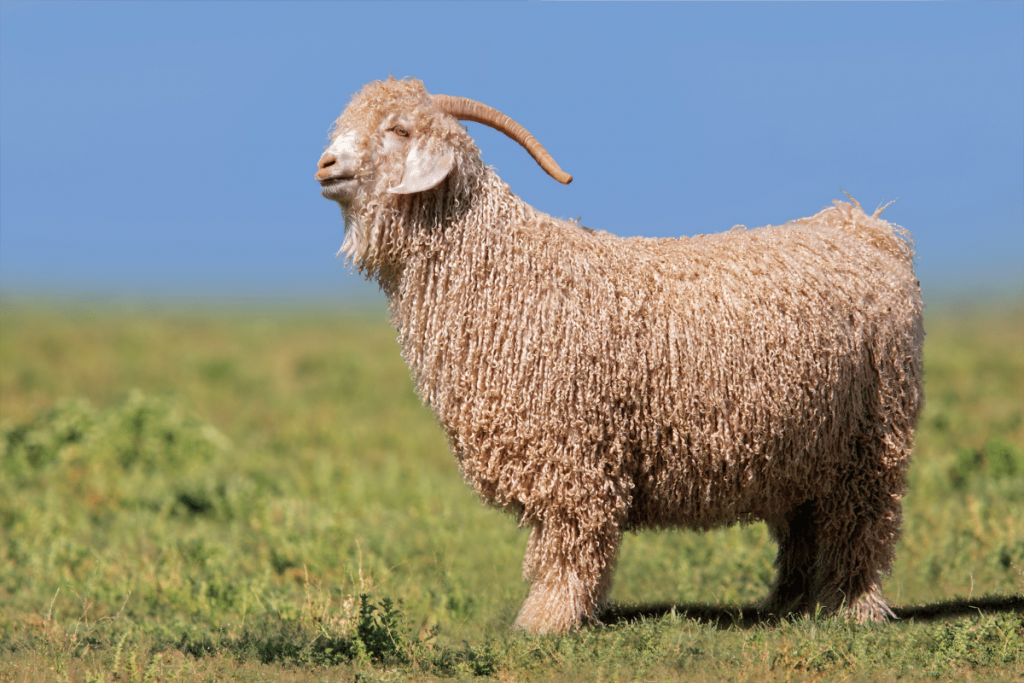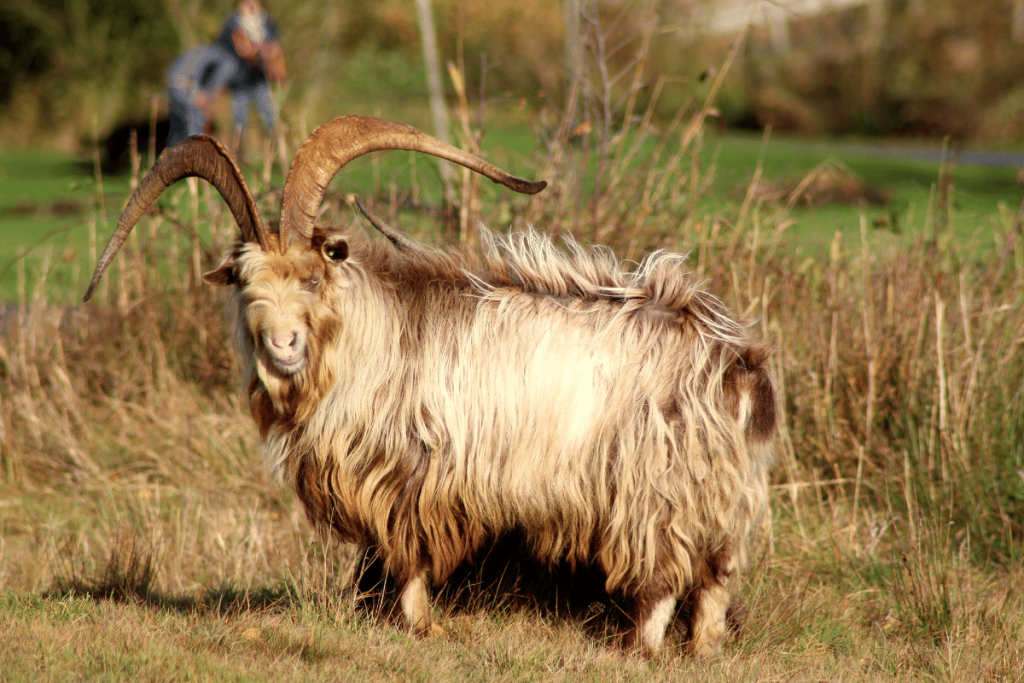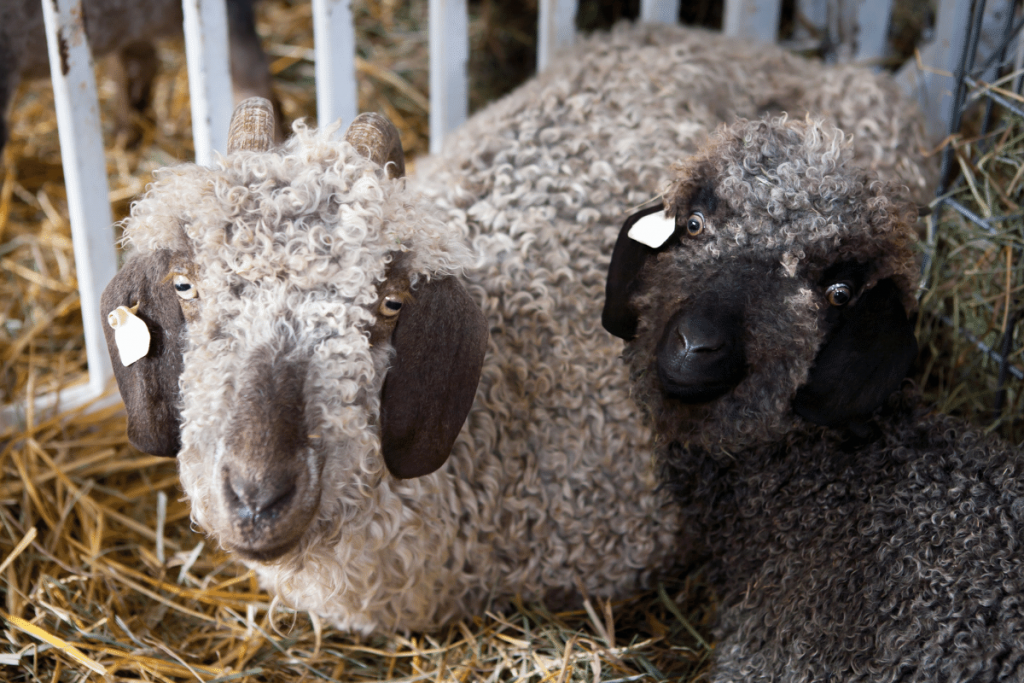When most of us imagine a goat, we don’t typically think of an animal with long, luxurious hair.
However, various goat breeds commonly used for fiber production have long, flowing locks, giving them a distinct appearance and personality.
Let’s look at five of the most visually striking and unique long-haired goat breeds below!
Table of Contents
ToggleAngora

The Angora breed is perhaps the one breed of goat on this list most people are familiar with.
This is mainly thanks to its widespread use in fiber production!
The Angora goat’s hair is used to create mohair, a soft and silky yet stretchy and durable fiber commonly spun into clothing.
In particular, Angora goat mohair is most commonly used to create warm, insulating winter clothing like furry boots, soft sweaters, lovely coats, silky scarves, and cozy hats, as well as spun into yarn and even used in rugs, carpets, and the occasional blanket.
It’s also often blended with other fibers like wool and spun into fabrics for various uses.
Because it is so soft and warm yet also lightweight, flexible, and durable, Angora goat fleece is extremely useful and fairly easy to farm.
Angora goats produce a lot of it–around 10 pounds per year, in fact!
Sadly, much of the Angora goat’s history is a mystery, but we know this adorably fluffy breed of goat hails from Turkey and has long been prized for its soft blanket of curly white hair.
It is generally believed they were first transported out of Turkey across Europe sometime in the 1500s.
They are a fairly small breed with a docile, friendly temperament, making them easy to care for.
Australian Cashmere

The Australian cashmere goat is another goat breed with super fluffy, dense hair!
As its name suggests, this breed comes from Australia and is primarily known and used for the production of the ultra-luxurious fiber cashmere.
The typical Australian cashmere goat’s coat is long, dense, and, most importantly, soft.
According to the breed standard, white coats are the most common, though other colors like tan and brown also exist.
White cashmere is typically the most prized and expensive due to how easy it is to dye various colors.
This domestic goat breed is also known for its easygoing temperament, meaning it fares well and breeds easily in captivity.
The first adult cashmere goats were exported from Australia to the UK in the 1830s, and they gradually became more popular in neighboring European countries for their long, soft hair.
In addition to being incredibly useful for its cashmere production and easy to care for, this agile long-haired goat is also very hardy and not prone to any health issues.
Dutch Landrace

The Dutch Landrace is a unique-looking horned goat breed, primarily thanks to its long, soft hair in a wide range of colors and patterns from white, cream, brown, grey, black, and even auburn.
Some Dutch Landrace goats have shorter coats, but long, dense, wiry hair is most common.
Aside from its flowing coat, the Dutch Landrace’s next most prominent trait is its short, stocky build, similar to a pygmy or Nigerian Dwarf goat’s stature.
It is also common for Dutch Landrace goats to have large, upward-pointing horns, which present in various possible shapes.
This Dutch breed has been documented and farmed in the Netherlands since the 1600s.
It remained a popular breed for hundreds of years.
Sadly, these cute goats nearly went extinct in the 1950s, but the breed’s numbers have since been restored somewhat thanks to careful, repeated captive breeding and crossbreeding with other goat breeds.
The Dutch Landrace’s adorably small size, calm, independent temperament, hardy nature, and long, flowing hair make it a fairly popular breed for various uses, from fiber production to milk and meat, and even as a beloved pet for many hobby farmers.
Pygora

As its name implies, the Pygora goat breed is the long-haired, small-bodied result of crossbreeding the Angora and American Pygmy goat breeds.
It was originally created in Oregon City, Oregon, in 1980 via crossbreeding, and the Pygora Breeders Association was created soon after in 1987.
The Pygora’s hair can produce three distinct textures of fleece and is used in fiber production, where it is most commonly spun into yarn, blended with other fabrics, and used to create various articles of clothing.
Due to its partial Pygmy goat ancestry, the Pygora goat’s hair is similar in texture, yet slightly shorter in overall length, to the hair of true Angora goats.
In addition to fiber production, these medium-sized goats are commonly kept as pets and used for show due to their small, manageable size, agreeable and docile temperament, and attractive, fluffy coat.
Pygora coats are in a wide range of colors and patterns, though white Pygora hair is the most expensive and prized.
The hair’s texture is typically irregular ringlet curls with a soft yet durable structure.
Anatolian Black
The Anatolian Black goat breed hails from Turkey and has long, flat, coarse black hair covering much of its body.
Related: Great looking black and white goat breeds
Its long, droopy ears hang down and frame the sides of its face.
Coat colors vary, from dark brown to grey to black, though solid black is the most common variety.
Hardy, strong, and agile, the Anatolian Black breed is commonly bred for fiber production, meat, and, to a lesser extent, dairy purposes.
It tolerates a range of temperatures well despite its long coat and drooping ears.
Oddly, while its body is covered with a thick coat of hair, the goat’s legs, head, and neck all have much shorter coats.
To sum up, if you love beautiful long-haired goats, the Anatolian Black goat is a well-rounded choice that suits many different types of owners’ preferences.
Thanks to its easygoing, reliable temperament, it fares well in captivity. Its unique appearance, namely its long ears and sleek, cloak-like coat, makes it an interesting pet and show breed.
Finally, its healthy immune system and natural resistance to a wide range of common diseases mean it tends to live a long time and doesn’t cost much in veterinary care, making it a good fit for expert and novice livestock keepers.
Further Reading: Goat breeds without horns (pictures included!)
How useful was this post?
Click on a star to rate it!
We are sorry that this post was not useful for you!
Let us improve this post!
Tell us how we can improve this post?
